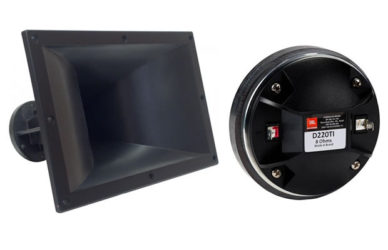| Dayton H812 with Selenium D220Ti
Having tested out the Dayton D250P Polyimide compression driver before this, it’s time for the Dayton H812 to meet the selenium D220Ti titanium driver. The woofer, a Dayton RS180S, is retained. It is exactly the same setup as the D250P review. The only difference is the Selenium D220Ti now replaces the Dayton D250P. This will allow for an easier comparison. |
 |
|
Frequency Response The Black trace in Fig 1, is the RAW response of the Selenium D220Ti mated with the H812. The Blue trace is with a 24dB/oct filter at 950Hz. |
|
|
Improper Summing The Red trace in Fig 2 is the summed response of the D220Ti/H812 with the Dayton RS180S. Due to the large offset of their acoustic centers (the D220Ti is about 8″ deep), it resulted in some cancellation to the right of the crossover frequency. |
|
|
Checking Crossover Frequency The Red trace in Fig 3 is the response when the D220Ti has it’s polarity reversed. It appears the two drivers are crossing at 700Hz. |
|
|
Adding Delay With the D220Ti still wired in reversed polarity, a delay was added to the RS180S. When the delay time is spot on, a narrow, deep notch will result (Red trace in Fig 4). Notice that this is also the same frequency that the two drivers have crossed. |
|
|
Time Alignment The Red trace in Fig 5 is with the D220Ti re-wired back to normal polarity. The two drivers are now time-aligned. There are no cancellations on either side of the crossover frequency because sounds from the D220Ti and the RS180S arrive at the listener’s position at the same time. |
|
| Sound Quality
I love this setup. Speaker sounds dynamic. The treble is there without being bright. Lots of depth in the highs. I’ve come across complaints that this Selenium compression driver is not the best sounding. Frankly, I have no issues with it. To me, it sounds very good. No brightness or harshness. It’s a fantastic buy for $50. Perhaps the problem is not from the Selenium driver but with the way it’s used. Compression drivers and horns are not very forgiving. If they are not done right, they will sound horrible. Technical The Dayton H812 with the Selenium D220Ti is one of the best combination I’ve come across. Absolutely flat all the way up to 10kHz. Beyond which, it rolls off linearly to 20kHz (-15dB). You can be assured of no honking, no unevenness in the response, no fussy equalization required, no nothing. Simply decide on your crossover frequency and that’s it. For the perfectionist, run the speaker bi-amp. One power amplifier for the woofer and one for the compression driver. Add in a 24dB/oct Linkwitz Riley electronic crossover with delay features and you can have a perfectly time aligned 2-way. You’ll never look back after this. All measurements were made with the microphone at 1 meter, on tweeter axis. Gating is at 5 msec and No Smoothing applied. This page was last modified on 10 Mar, 2018. |
|




 Fig 4 – Frequency Response with Delay Added
Fig 4 – Frequency Response with Delay Added